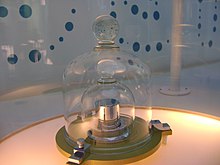
Platinum–iridium alloys are alloys of the platinum group precious metals platinum and iridium.
Typical alloy proportions are 90:10 or 70:30 (Pt:Ir). These have the chemical stability of platinum, but increased hardness. The Vickers hardness of pure platinum is 56 HV while platinum with 50% of iridium can reach over 500 HV. This improved hardness has also been considered as beneficial for use in platinum jewellery, particularly watch cases.
Owing to their high cost, these alloys are rarely used. They have been used for spinnerets in the manufacture of synthetic fibres.
Their well-known use is in metrology, where they were used to make the international prototypes used by international standards bodies for mass standards such as the International Prototype of the Kilogram and the International Prototype Metre, although both have been superseded during the 2019 revision of the SI.
The other extremely widespread use for Pt/Ir alloy is fabrication of metal microelectrodes for electrical stimulation of nervous tissue and electrophysiological recordings. Pt/Ir alloy has an optimal combination of mechanical and electrochemical properties for this application. Pure iridium is very difficult to pull into small diameter wires; at the same time, platinum has a low yield strength, which makes pure platinum wires bend too easily during insertion into nervous tissue. Additionally, platinum–iridium alloys containing oxides of both metals can be electro-deposited onto the surface of microelectrodes.
References
- Darling, A. S. (1960). "Iridium Platinum Alloys" (PDF). Platinum Metals Review. 4 (l): 18–26. Bibcode:1960Natur.186Q.211.. doi:10.1038/186211a0. Retrieved 2008-10-13.
- Biggs, T.; Taylor, S. S.; Van der Lingen, E. (2005). "The Hardening of Platinum Alloys for Potential Jewellery Application". Platinum Metals Review. 49 (1): 2–15. doi:10.1595/147106705X24409.
- Egorova, R. V.; Korotkov, B. V.; Yaroshchuk, E. G.; Mirkus, K. A.; Dorofeev N. A.; Serkov, A. T. (1979). "Spinnerets for viscose rayon cord yarn". Fibre Chemistry. 10 (4): 377–378. doi:10.1007/BF00543390. S2CID 135705244.
- Cogan, SF; Troyk, PR; Ehrlich, J; Plante, TD (September 2005). "In vitro comparison of the charge-injection limits of activated iridium oxide (AIROF) and platinum-iridium microelectrodes". IEEE Transactions on Bio-Medical Engineering. 52 (9): 1612–4. doi:10.1109/tbme.2005.851503. PMID 16189975. S2CID 19297044.
- Cogan, Stuart F. (August 2008). "Neural Stimulation and Recording Electrodes". Annual Review of Biomedical Engineering. 10 (1): 275–309. doi:10.1146/annurev.bioeng.10.061807.160518. PMID 18429704.
- Stein, Richard B.; Charles, Dean; Gordon, Tessa; Hoffer, Joaquin-Andres; Jhamandas, Jack (November 1978). "Impedance Properties of Metal Electrodes for Chronic Recording from Mammalian Nerves". IEEE Transactions on Biomedical Engineering. BME-25 (6): 532–537. doi:10.1109/TBME.1978.326287. PMID 744599. S2CID 7973265.
- Malagodi, Mark S.; Horch, Kenneth W.; Schoenberg, Andrew A. (July 1989). "An intrafascicular electrode for recording of action potentials in peripheral nerves". Annals of Biomedical Engineering. 17 (4): 397–410. doi:10.1007/BF02368058. PMID 2774314. S2CID 23762187.
- "Platinum Group Coatings".